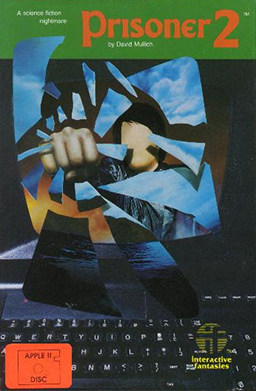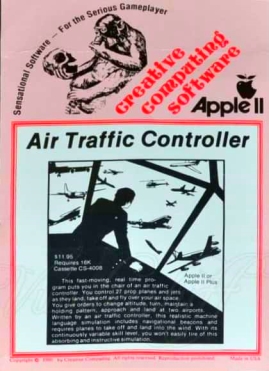
The Atari 8-bit computers, formally launched as the Atari Home Computer System, are a series of home computers introduced by Atari, Inc., in 1979 with the Atari 400 and Atari 800. The architecture is designed around the 8-bit MOS Technology 6502 CPU and three custom coprocessors which provide support for sprites, smooth multidirectional scrolling, four channels of audio, and other features. The graphics and sound are more advanced than most of its contemporaries, and video games are a key part of the software library. The 1980 first-person space combat simulator Star Raiders is considered the platform's killer app.

Star Raiders is a space combat simulator video game created by Doug Neubauer and published in 1980 by Atari, Inc. Originally released for the Atari 400/800 computers, Star Raiders was later ported to the Atari 2600, Atari 5200, and Atari ST. The player assumes the role of a starship fighter pilot, who must protect starbases from invading forces called Zylons. Piloting and combat are shown in the 3D cockpit view, while a 2D galactic map shows the state of the Zylon invasion. Neubauer made the game in his spare time at Atari, inspired by contemporary media such as Battlestar Galactica and Star Wars, as well as the 1971 mainframe game Star Trek.

Miner 2049er is a platform game game developed by Big Five Software and published in December 1982. It is set in a mine, where the player controls the Mountie Bounty Bob. The player controls Bounty Bob through multiple levels of a mine, with the goal of traversing all of the platforms in each level all while avoiding enemies and within a set amount of time.

Star Trek is a text-based strategy video game based on the Star Trek television series (1966–69) and originally released in 1971. In the game, the player commands the USS Enterprise on a mission to hunt down and destroy an invading fleet of Klingon warships. The player travels through the 64 quadrants of the galaxy to attack enemy ships with phasers and photon torpedoes in turn-based battles and refuel at starbases. The goal is to eliminate all enemies within a random time limit.

Starmaster is a video game written for the Atari 2600 by Alan Miller and published in June 1982 by Activision. The game involves the player travelling through space attacking enemy starfighters who are invading starbases. The player traverses through a map called the galactic chart to destroy all the enemies and survive against oncoming enemy attacks and crashing with meteors.

ANALOG Computing was an American computer magazine devoted to Atari 8-bit computers. It was published from 1981 until 1989. In addition to reviews and tutorials, ANALOG printed multiple programs in each issue for users to type in. Almost every issue included a machine language video game—as opposed to Atari BASIC—which were uncommon in competing magazines. Such games were accompanied by the assembly language source code. ANALOG also sold commercial games, two books of type-in software, and access to a custom bulletin-board system. After the Atari ST was released, coverage of the new systems moved to an ST-Log section of the magazine before spinning off into a separate publication under the ST-Log name.

Star Trek: Strategic Operations Simulator is a space combat simulation arcade video game based on the original Star Trek television program and movie series, and released by Sega in 1983. Star Trek uses color vector graphics for both a 2D display and a 3D first-person perspective. The player controls the Starship Enterprise and must defend sectors from invading Klingon ships. The game includes synthesized speech
Datasoft, Inc. was a software developer and publisher for home computers founded in 1980 by Pat Ketchum and based out of Chatsworth, California. Datasoft primarily published video games, including ports of arcade video games, games based on licenses from movies and TV shows, and original games. Like competitor Synapse Software, they also published other software: development tools, word processors, and utilities. Text Wizard, written by William Robinson and published by Datasoft when he was 16, was the basis for AtariWriter. Datasoft initially targeted the Atari 8-bit computers, Apple II, and TRS-80 Color Computer, then later the Commodore 64, IBM PC, Atari ST, and Amiga. Starting in 1983, a line of lower cost software was published under the label Gentry Software.

The Prisoner 2 is a video game published in 1982 by Edu-Ware. It is a remake of the 1980 game The Prisoner.

The Chessmaster 2000 is a computer chess game by The Software Toolworks. It was the first in the Chessmaster series and published in 1986. It was released for Amiga, Apple II, Atari 8-bit computers, Atari ST, ZX Spectrum, Commodore 64, Amstrad CPC, MSX, Macintosh, and IBM PC compatibles.
Quality Software is a defunct American software developer and publisher which created games, business software, and development tools for the Exidy Sorcerer, Apple II, and Atari 8-bit computers in the late 1970s and early 1980s. Asteroids in Space, written by programmer Bruce Wallace, was voted one of the most popular games of 1978-80 by Softalk magazine.
Tom Hudson is an American programmer best known for co-creating the 3D modeling and animation package 3D Studio as well as creating its precursor, CAD-3D for the Atari ST.

Ogre is a 1986 video game based on the Ogre board wargame. It was released by Origin Systems for the Apple II, Amiga, Atari 8-bit computers, Atari ST, Commodore 64, MS-DOS, and Mac.

Air Traffic Controller is a video game written by air traffic controller David Mannering. It was released by Creative Computing for the TRS-80 Model I and Exidy Sorcerer in 1978, and for the Apple II and Sol-20 in 1979. It was rewritten by Will Fastie and Bill Appelbaum for Data General AOS in 1980 and ported to MS-DOS for release by PC Disk Magazine in 1983.

Phantasie is the first video game in the Phantasie series.

Chopper Hunt is a side-view shoot 'em up written by Tom Hudson and published by Imagic in 1984 for Atari 8-bit computers and Commodore 64. It was one of the last games from Imagic before the company went out of business. Chopper Hunt is an enhanced version of the Atari 8-bit game Buried Bucks released by ANALOG Software in 1982. In both games, the player files a helicopter that uses bombs to unearth buried items. Contemporaneous reviews were mixed.

Lunar Lander is a 1980 video game published by Adventure International.

Pool 1.5 is a pool simulation video game written for the Apple II and published by Innovative Design Software in 1981. A port for Atari 8-bit computers was released the same year. Pool 1.5 allows 1 to 4 people to play one of 4 variations: straight pool, eight-ball, nine-ball, and rotation. A trimmed down version was released on cartridge for the Atari 8-bit computers in 1982 as Pool 400. The "400" refers to the Atari 400 computer, which shipped with less memory than the more expensive Atari 800.

Flak: The Ultimate Flight Experience is a vertically scrolling shooter for the Atari 8-bit computers designed by Alain Marsily, programmed by Yves Lempereur, and published by Funsoft in 1984. It was ported to the Apple II, Commodore 64, and ZX Spectrum home computers. Flak was heavily inspired by the 1982 Namco arcade video game Xevious. Most critical reviews were middling or harshly negative.
















